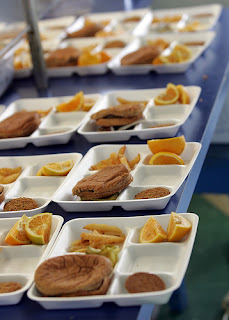The headline of this article caught my eye:
School Lunch Proposals Set Off a Dispute.
What is there to dispute, I wondered? The first paragraph, which
described the changes that the USDA wants require in school
lunch menus, made perfect sense to me. Cut back on potatoes, add more
fruits and vegetables, and reduce salt. Kids couldn't have more than two servings of starchy vegetables a week, so this would cut back on French fries and other forms of potatoes, and would add in new produce like spinach and peaches. I like this idea, a lot. Forty percent of children's daily calories come from the lunch they eat
at school. So, we should make those lunches healthier. What's not to
like about this idea?
Apparently, a lot. The USDA is facing a whole slew of people who don't want these regulations to pass. This includes senators from potato-producing states (who say we shouldn't limit the amount of starchy food kids consume), food lobbyists (who say that kids won't eat the new vegetables), and frozen food companies (who say the reduced-salt guidelines will be too costly to follow). Because these people have so much power and sway in our country, the USDA guidelines will likely not pass.
This frustrates me beyond belief.
As a substitute teacher in an urban Michigan area, I teach in a lot of schools and get to see a lot of school lunches. Not once have I seen a meal that I would be willing to eat. Friday's lunch, served to the kindergarten class where I was subbing, was no exception. The main "entree" was a gigantic piece of bread with an inch of greasy white cheese melted on top. This came with milk (plain, chocolate or strawberry -- and which option do you think most kids took?), tiny carrot sticks, a flavored yogurt tube, and a frozen fruit popsicle. While this isn't the worst meal I could think of, it's laden with sugar, and most students probably didn't eat the healthiest item they were offered - the carrots. It's understandable that the kids don't eat carrots when they can fill up on all the other sugary options.
Who eats these types of lunches? Mostly students who receive free or reduced-price lunch, which means they are from low income families. And which group of children has the highest obesity rate in the U.S.? Children from low-income families, and children of color.
This is particularly frustrating when I compare it to the food offered where I taught last year, at a private school in upstate New York. This school had a daily salad bar with multiple greens, grains, and vegetables offered. The entrees included lentil meatloaf, vegetable stir fry, and curry beef stew. The meat was locally sourced and usually organic, and dessert was only served on Thursdays.
Who eats these types of lunches? Students from middle- and upper-income families.
I know that it's not realistic for all public schools to serve organic beef and an elaborate array of freshly chopped vegetables. They have a tight budget and limited kitchen staff. But no one is asking for that kind of a menu. The USDA is asking for meals that are just slightly healthier. A few less potatoes, a little less salt, and a bit more vegetables. In a country that claims to care about its children's health, this shouldn't be too much to ask.
Photo credit

